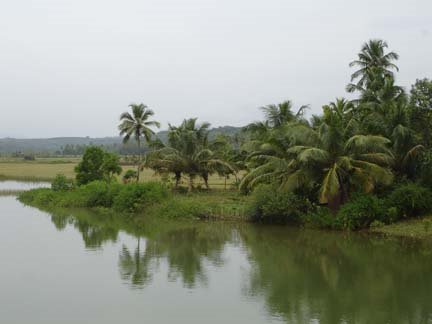The place name Pirak, where several early Indian tribes, including Vedic and Tulu tribes lived formed words pirak in Tulu, prak in Prakrit and Sanskrit that carries the meaning ‘ancient’. Probably, the words were formed after these tribes migrated from the pirak area into present Indian lands.
All these tribes possibly worshipped Brahma or the Brahman (referred to in Vedas and Upanishads). Tulu people called their early God, Bermer (the respectful word for the Brahma, pronounced as berm’er). The –er is a plural indicative or respect indicative suffix in Tulu. The migrating Tulu tribes later carried Bermer concept to their Tulunad homeland. The Bermer was the prominent God for Tulu people for centuries. Bermere gunda or Brahmasthana (=Brahmas shrine) were existing in many Tulunad villages till seventies or eighties. There may still be some relics of them in remote villages.The lyrical folk literature of Tulu people, pad-dhana, describe Tulu heros Koti and Chennaya worshipping the God Bermer. The Garodis (traditional gymnasiums of Tulunad ) had idols of the God Bermer. Interestingly, the idols of Bermer, in most cases I know, were represented by a human male figure mounted on horse. Italian tourist Della Valle who visited Queen Abbakka Devi at Ullal, a small coastal town south of Mangalore, Karnataka, during AD 1623, also described a similar idol of Bermer, within a small shrine in the area.
With the ascent of Shiva and Durga worships in Tulunad the Bermer concept is slowly vanishing. However, the word bermer was further extended as suffix denoting God to Naga bermer (=Naga /serpent God) also devotedly worshipped by Tulu people.
There is a Brahma temple in Pushkar, Rajasthan and this has been described as the only Brahma temple in
It appears that the concept of Brahma or Bermer worship has evolved with the passage of time. The relics of early clay horse statues found in the Pirak region by archeological excavation teams (ca.1700 BC), possibly represent the Bermer as worshipped by Tulu people until recently. The original Brahma, a human male figure straddled on a horse, might have been worshipped as the Creator or Almighty by early Indian (Tulu and Vedic) tribes. Subsequently, as a consequence of domination of Shiva and Vishnu cults, the original horse-seated Brahma might have been evolved into a four faced, Chaturmukha Brahma, with passage of time. Thus we can distinguish the early horse riding Bermer and the subsequent four faced neo-Brahma stages in Brahma worship in Indian subcontinent.
The Pushkar region is a place of ancient civilization where early Brahma/ Bermer was being worshipped. With passage of time, the appearance of Brahma has also underwent change in Pushkar. The Brahma temple in Pushkar now presents a four faced Brahma idol.
Even with evolution of his appearance, the Brahma has retained his position as creator of the world in Indian mythology. However, with dominance of Shaiva, Shaktha and Vaishnava philosophies, the concept of the original creator Brahma as supreme God has taken a back seat.
The migrant Tulu tribes carried Bermer concept with them to Tulunad, before the Shaivism made major impact in southern


